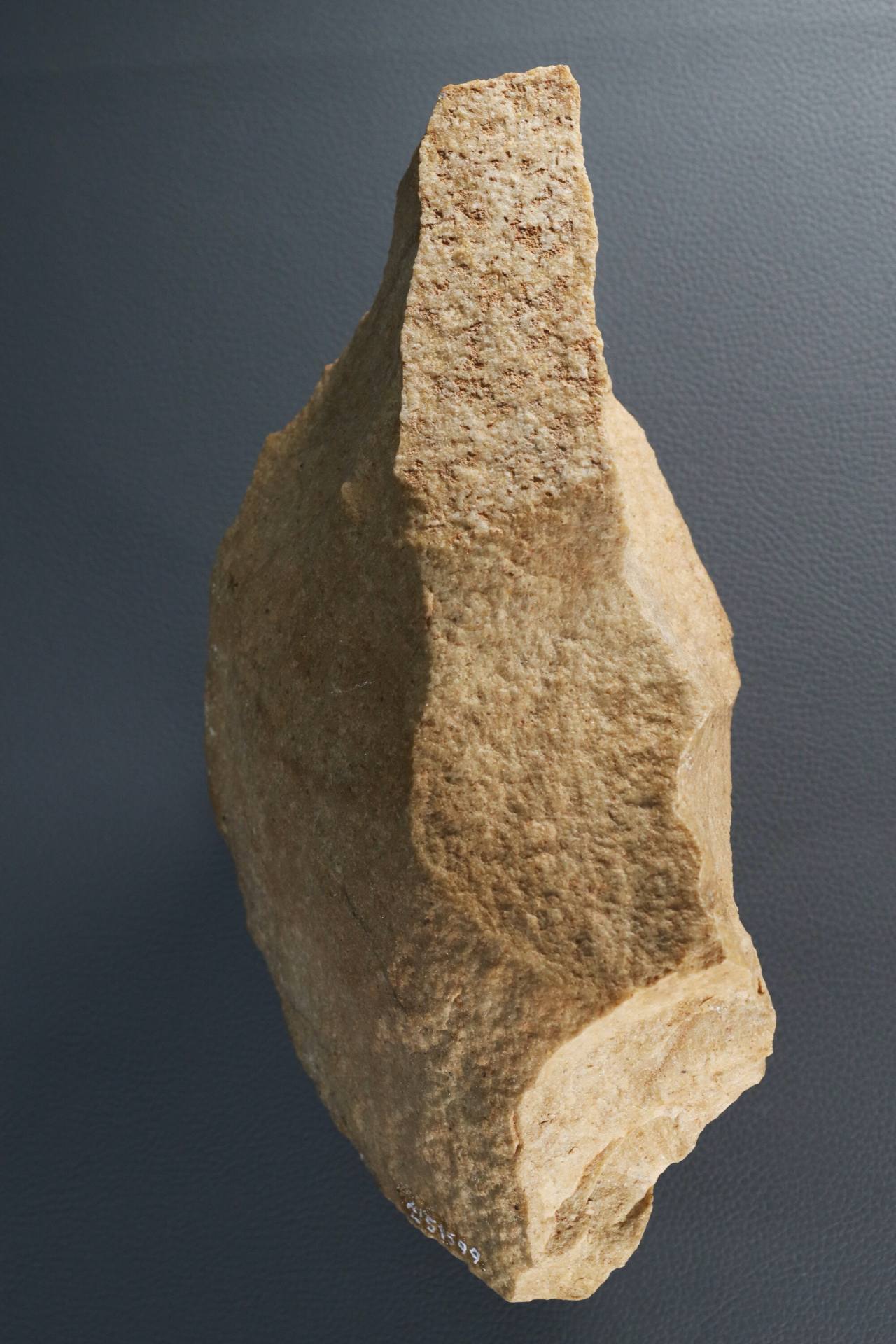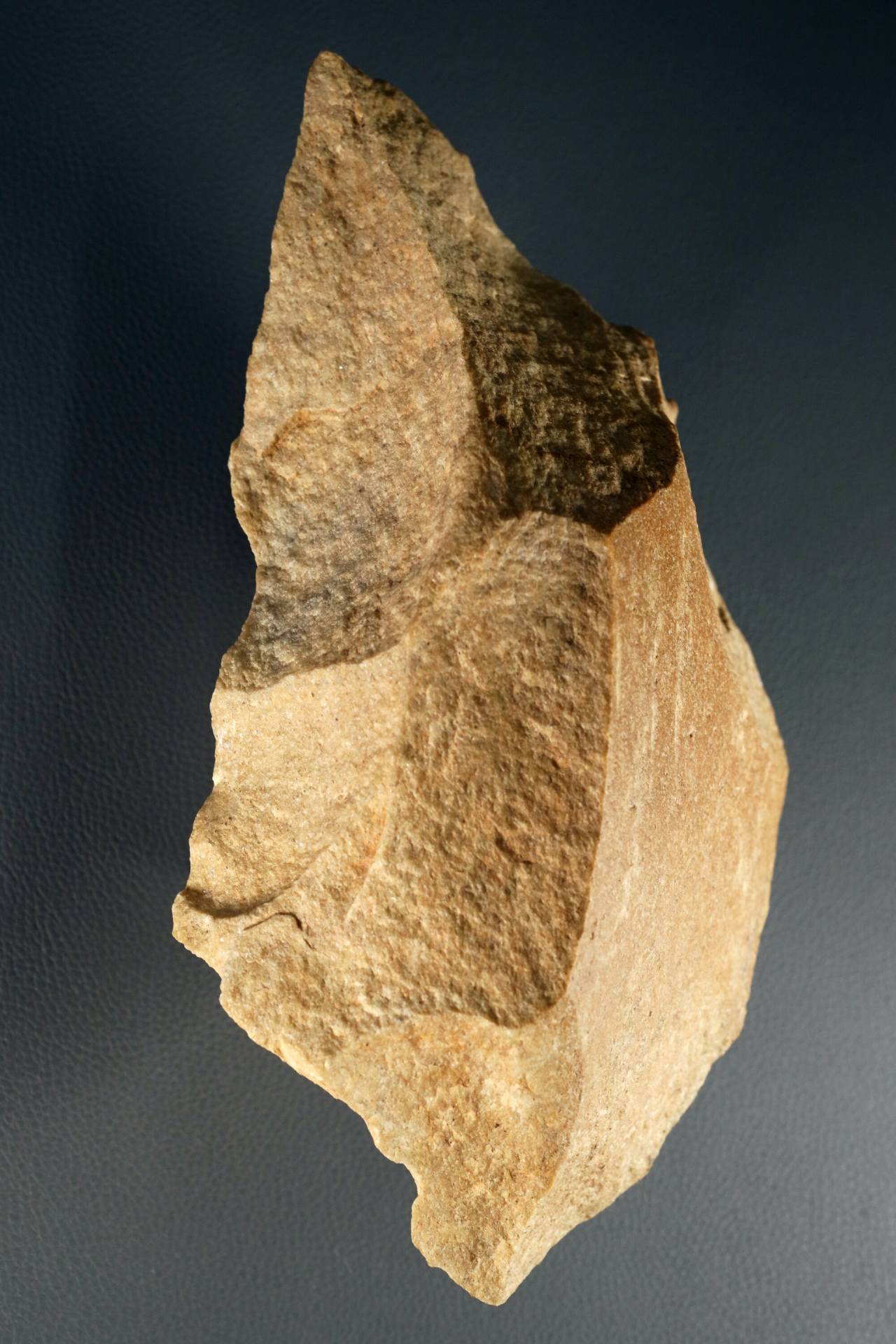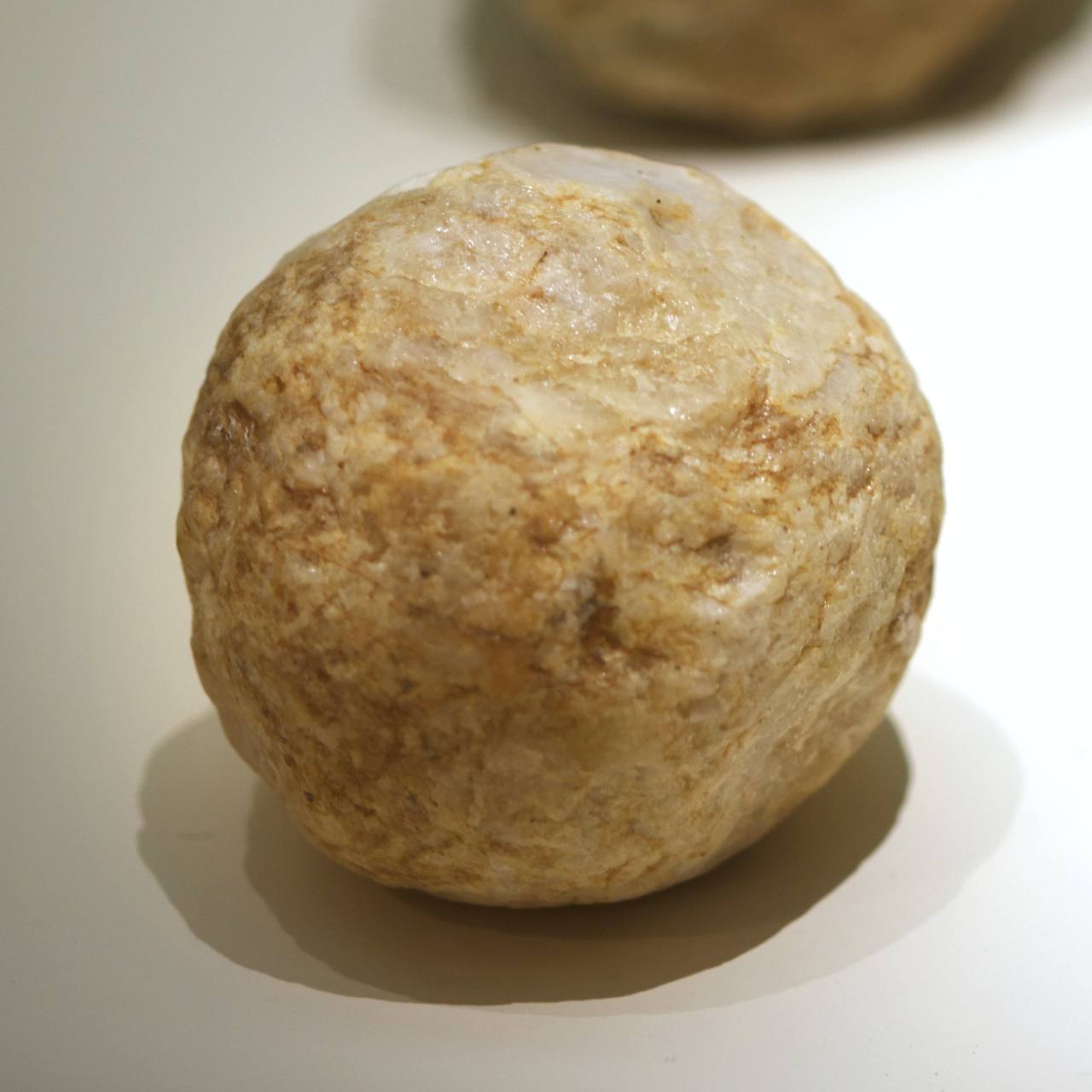[Visual History of Korea] Cutting-edge Stone Age tool Jeongok-ri handaxe of Korea
By Korea HeraldPublished : Feb. 12, 2022 - 16:01

Long before the Upper Paleolithic Period, the late Stone Age, during which our immediate ancestors the Homo sapiens inhabited the Korean Peninsula, there were ancient Hominin, a group consisting of extinct human species and all our immediate ancestors who lived in Korea.
The Stone Age all over the world was characterized by the use of rudimentary chipped stone tools, of which an abundant variety are found in Korea.
When an Acheulean-like handaxe, a Paleolithic period tool, which was the cutting-edge tool of Hominins back in the Stone Age, was found in Korea by Greg Bowen, a young US airman who in 1978 was stationed in Korea, the discovery placed Korea on the paleo-archeology map of the world.
Bowen was out on a date with his future wife Yi Sang-mi when he found a biface handaxe, the stone handaxe which was chipped on both sides of the blades (four sides), in Jeongok-ri located about two hours’ drive north of the capital city Seoul, along Hantan River in Gyeonggi Province.
According to Yongwook Yoo, a professor of archaeology at Chungnam National University, diverse types of stone tools such as hand axes, cleavers, hunting stones, fist-sized picks, scrapers, notched tools and others were unearthed from the sedimentary layer in the Imjin-Hantan River Area near Jeongok-ri between 1979 and 2010.
Korean researchers have been busy digging for ancient clues in the area since Bowen‘s discovery of the Jeongok-ri handaxe and more than 100 Acheulian-like handaxes have been discovered.

Jeongok-ri handaxe was a tool for Hominins on the Korean Peninsula, which was local technology, differentiated from the Acheulean handaxe, according to Yoo.
Before the discovery of the Jeongok-ri handaxe, Eurocentric archeology did not believe there were Acheulean-like handaxes in Asia. The biface cutting tool, the stone tool chipped symmetrically on both sides from all four angles, was believed to be an exclusive technology of the Homo erectus period, when ancient human ancestors first started walking on two feet.
In earth’s history, the large chipped-stone handaxe, commonly known now as Acheulean bifaces, were one of the oldest, most common and longest-used tools for ancient Hominins.
Researchers have debated about the age of the Jeongok-ri handaxe for decades.
Based on the most recent scientific tests and findings, Yoo of CNU says, “There’s some attraction to dating archeological relics blindly old, but I believe the Jeongok-ri handaxe falls somewhere between 70,000 to 40,000 years old.“
The Korean Peninsula is defined by numerous mountains and rocks have always been a great resource for people who live here.
Before the discovery of the Jeongok-ri handaxe, Eurocentric archeology did not believe there were Acheulean-like handaxes in Asia. The biface cutting tool, the stone tool chipped symmetrically on both sides from all four angles, was believed to be an exclusive technology of the Homo erectus period, when ancient human ancestors first started walking on two feet.
In earth’s history, the large chipped-stone handaxe, commonly known now as Acheulean bifaces, were one of the oldest, most common and longest-used tools for ancient Hominins.
Researchers have debated about the age of the Jeongok-ri handaxe for decades.
Based on the most recent scientific tests and findings, Yoo of CNU says, “There’s some attraction to dating archeological relics blindly old, but I believe the Jeongok-ri handaxe falls somewhere between 70,000 to 40,000 years old.“
The Korean Peninsula is defined by numerous mountains and rocks have always been a great resource for people who live here.

“Homo sapiens were excellent problem solvers. We have found pieces of Obsidian, a dark volcanic glass formation rock, used to make weapons and tools and which are only available near Baekdu Mountain in the Korean Peninsula, in the Imjin-Hantan River area,” said Yoo. The Imjin-Hantan River area is several hundred kilometers away from Baekdu Mountain, the source of the Obsidian rocks. “It’s evidence that they traveled hundreds of kilometers to find high-quality raw material,” said Yoo.
The main difference between the Korean Acheulean-like handaxe and the Acheulean handaxe of Europe and Africa is the raw material. “The way in which the stone chips off makes the Korean handaxe look more rough,” said Yoo.
Lots of baseball-sized, highly weathered and used hammer stone, also called a spherical polyhedron-bola from the Stone age were also found in the Imjin-Hatan River area.
“The spherical rock was probably made when it was used to strike a handaxe or other stone tool and its edges were worn down,” said Yoo. The hammer stone is also found in other areas in Korea, reflecting the widespread knowledge of stone tool-making at the time.
“I can definitely say that Jeongok-ri is a very important site that shows the early Hominin activities” said Sang-Hee Lee, a professor of anthropology at University of California at Riverside.
Bowen, who made the remarkable discovery during his time in Korea, studied anthropology at the University of Arizona upon returning to the US with his wife Sang-mi Bowen, and worked for the Navajo Nation Historic Preservation Department until his retirement. He died in Arizona in 2009.
By Hyungwon Kang (hyungwonkang@gmail.com)
---
Korean American photojournalist and columnist Hyungwon Kang is currently documenting Korean history and culture in images and words for future generations. -- Ed.
The main difference between the Korean Acheulean-like handaxe and the Acheulean handaxe of Europe and Africa is the raw material. “The way in which the stone chips off makes the Korean handaxe look more rough,” said Yoo.
Lots of baseball-sized, highly weathered and used hammer stone, also called a spherical polyhedron-bola from the Stone age were also found in the Imjin-Hatan River area.
“The spherical rock was probably made when it was used to strike a handaxe or other stone tool and its edges were worn down,” said Yoo. The hammer stone is also found in other areas in Korea, reflecting the widespread knowledge of stone tool-making at the time.
“I can definitely say that Jeongok-ri is a very important site that shows the early Hominin activities” said Sang-Hee Lee, a professor of anthropology at University of California at Riverside.
Bowen, who made the remarkable discovery during his time in Korea, studied anthropology at the University of Arizona upon returning to the US with his wife Sang-mi Bowen, and worked for the Navajo Nation Historic Preservation Department until his retirement. He died in Arizona in 2009.
By Hyungwon Kang (hyungwonkang@gmail.com)
---
Korean American photojournalist and columnist Hyungwon Kang is currently documenting Korean history and culture in images and words for future generations. -- Ed.
-
Articles by Korea Herald







![[KH Explains] Hyundai's full hybrid edge to pay off amid slow transition to pure EVs](http://res.heraldm.com/phpwas/restmb_idxmake.php?idx=644&simg=/content/image/2024/04/18/20240418050645_0.jpg&u=20240419100350)







![[From the Scene] Monks, Buddhists hail return of remains of Buddhas](http://res.heraldm.com/phpwas/restmb_idxmake.php?idx=652&simg=/content/image/2024/04/19/20240419050617_0.jpg&u=20240419175937)

![[KH Explains] Hyundai's full hybrid edge to pay off amid slow transition to pure EVs](http://res.heraldm.com/phpwas/restmb_idxmake.php?idx=652&simg=/content/image/2024/04/18/20240418050645_0.jpg&u=20240419100350)

![[Today’s K-pop] Illit drops debut single remix](http://res.heraldm.com/phpwas/restmb_idxmake.php?idx=642&simg=/content/image/2024/04/19/20240419050612_0.jpg&u=)